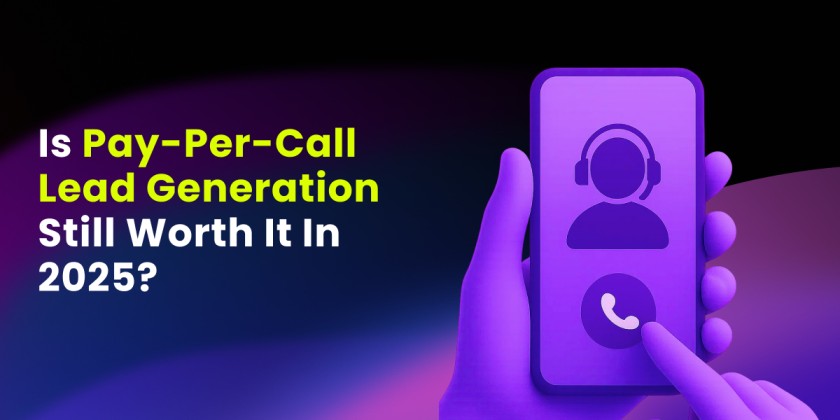Landing pages are the foundation of marketing campaigns because that’s how you get users to buy products or services. There are many types of landing pages, but they all usually follow the same design process, and that includes optimization.
In this article, we’ll examine why landing page optimization matters and the top 20 best practices in landing page optimization for 2026.
We’ll explore the whole design process, from pre-launch to building the core elements and post-launch testing. Let’s get into it!
Jump to Section:
🚀 KEY TAKEAWAYS
- Understand the industry benchmarks to create strategies that will be advantageous against competitors.
- Optimization doesn’t just happen after launching your landing page. Landing page optimizations happen throughout the whole design process.
- Optimization isn’t a one-and-done process; it’s a continuous journey that needs consistent testing to find the optimal landing page for your offer.
What is the Meaning of Landing Page Optimization?
Landing page optimization is the process of making your landing pages work better to turn more visitors into customers or leads.
It’s about testing and improving different parts of your page, like:
- Headlines
- Text
- Pictures
- Buttons
- Forms
- Overall design
The core meaning of landing page optimization centers on:
- Increasing conversion rates – Getting more visitors to complete your desired action (sign up, purchase, download, etc.)
- Improving user experience – Making the page easier to use and understand so visitors can quickly find what they need
- Enhancing relevance – Making sure the landing page content matches what visitors expect to find based on where they came from (ads, emails, etc.)
- Reducing friction – Removing anything that might stop users from converting (long forms, slow loading times, etc.)
- Data-driven decision making – Using analytics, A/B testing, and user feedback to guide improvements rather than relying on guesswork
Why Optimize Your Landing Page?
Before we dive in, let’s discuss the reasons for optimizing your landing pages. When you know your whys, it’s easier to navigate the hows.
Important Landing Page Statistics
What better way to tell you that landing page optimization is important than providing statistics on its performance, right? So, let’s discuss the numbers.
First off, the average landing page conversion rate is more than 7%.
Here’s how the median landing page conversion per industry looks from highest to lowest:
Data from Backlinko and Sender.
In the same report, they broke down the average landing page conversion rate by traffic channel from highest to lowest:
Conversion rates on landing pages differ significantly based on traffic sources:
Traffic from email is at the top with the highest landing page conversion rate of 19.3%. This may be because those who end up in email lists of businesses had more touchpoints with them, have targeted promotions, and are, therefore, more positioned to purchase.
Social Ads and Search Ads
In terms of advertising, paid search and social show significantly higher conversions than display networks.
This difference stems from user intent.
Search users actively seek solutions. Along the buyer’s journey, they are at the bottom of the funnel and are most likely to push through with accepting offers. This is especially true when you use keywords with purchase intent, such as “order,” “discount,” and, of course, “buy.”
Display or Banner Ads
On the other hand, display viewers are those who casually browse content. They are usually at the top of the funnel and are likely just looking for information instead of being ready to purchase.
So, what do all these stats mean for landing page optimization?
“Continuously refining your user’s experience to match search intent increases the likelihood of transforming casual browsers into qualified leads or customers.”
Conversion Rate Optimization (CRO)
CRO (conversion rate optimization) is the systematic process of testing and improving marketing assets. Landing pages are often the focus of conversion rate optimization strategies because visitors will likely encounter your offers here for the first time.
This specialized approach allows you to apply CRO principles to critical entry points of your sales funnel where first impressions matter most.
It matters because even minor improvements in conversion rates can dramatically multiply your marketing ROI.
Consider that you started with a 1% conversion. Then, you made a few tweaks, such as applying another high-converting CTA in the landing page, which now increased the conversion to 2%. Now, you’ve successfully boosted your performance by 100%! Isn’t that neat?
Improving conversion rates also helps lower customer acquisition costs and maximizes the return on your ad spend.

Benchmarking Data
Benchmarking in landing page optimization is crucial because it provides a contextual framework for evaluating your performance against industry standards.
Without benchmarks, you’re essentially operating in a vacuum, unable to determine if your 5% conversion rate represents remarkable success or concerning underperformance.
When you have access to benchmark data, you gain several significant advantages:
- Establishes important KPIs and success metrics
- Identifies improvement opportunities
- Provides competitive context
- Creates measurement milestones
But benchmark data alone isn’t sufficient.
The real power comes when you use data to guide optimization practices. This combination allows you to:
- Understand where your performance gaps exist (through benchmark comparisons)
- Implement specific, proven tactics to close those gaps (through actionable recommendations)
This approach delivers faster results with less trial and error, helping you improve performance without excessive spending or lengthy waiting periods.
A/B Testing
Landing page A/B testing lets you compare versions of copy, images, and call-to-action elements to determine which combination resonates best with your target audience.
Knowing your conversion rates when testing on different demographics, mediums, or channels hastens the optimization process.
20 Landing Page Optimization Practices
Landing page optimization isn’t a one-time task but a strategic process that spans the entire lifecycle of your page.
To make these practices more actionable, we’ve organized our top 20 optimization strategies into three distinct phases:
- Before Building (pre-launch planning),
- Core Landing Page Elements (important components), and
- Standard Practices (post-launch optimization).
This systematic approach ensures you’re optimizing at every stage of development, from initial concept through continuous improvement after launch.
Let’s explore these best practices within each phase of the design process.
Before Building
Here’s what may be an unconventional opinion: optimization can happen before you even launch your landing page.
Of course, you’ll have to learn to let go and publish eventually, but you need to consider the standard best practices in creating a highly converting landing page as you build it.
You need to learn WHAT to optimize to apply the best practices for landing page optimization.
Here’s how that process looks like:
1. Start with a Creative Brief
The creative brief will guide your whole design process and make the landing page cohesive.
Identify Project Goals
Remember, goals should be SMART (Specific, Measurable, Achievable, Relevant, and Time-bound).
Lay down KPIs and metrics that will show your success in marketing campaigns. This is where your stats and data come in handy.
Know Your Target Audience
Begin by defining exactly who your landing page is intended for, including their demographic characteristics, interests, and behaviors.
Understanding your ideal audience guides every aspect of your landing page design, from messaging to visual landing page elements.
Identify the Key Messaging
Identify the specific problems your target audience is trying to solve (also known as their pain points) and what motivates them to seek solutions like yours.
This understanding helps you craft messaging that directly addresses their concerns and positions your offering as the ideal solution.
Answer questions such as: What’s their emotional connection to your offer? What are their pain points? How can your offer solve their problems?
Detail Design Requirements
This includes the landing page’s visual identity, layout specifications, meeting accessibility standards, and more. We’ll elaborate on this in the next parts.
Desired User Experience
Apply the “Keep It Simple, Stupid” principle by designing pages that don’t make landing page visitors think too much about what action they should take next.
Simplicity in design creates clarity and makes it easier for visitors to follow your desired conversion path.
2. Clarify the Desired Action
While you have your creative brief, it is crucial that you understand what a conversion for your landing page means. The desired action must be clear in all your marketing assets, not just the landing page.
3. Check Domain Availability
Secure a relevant, memorable URL that aligns with your campaign and prevents last-minute scrambling if your preferred domain is taken.
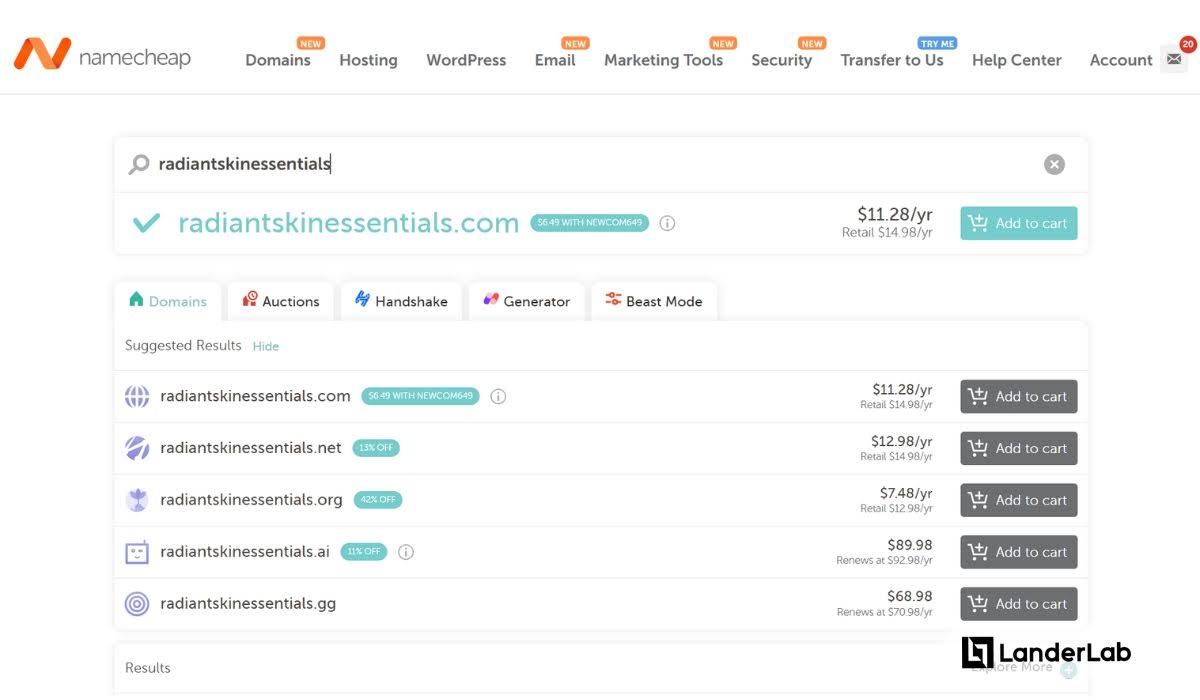
A strategically chosen domain that includes campaign keywords can improve search engine optimization (SEO) performance, especially if you’re an affiliate marketer promoting various brands and products.
Make it memorable and easier to find organically. Additionally, having campaign-specific domains allows for cleaner tracking and analytics.
4. Analyze Competitors
Analyzing competitors’ landing pages reveals effective strategies, design elements, and messaging approaches already working in your market. This helps you identify gaps in your own approach while avoiding common pitfalls that others have already navigated.
Additionally, understanding the competitive landscape allows you to differentiate your offering and create landing pages that stand out from competitors.
You can use Semrush and SimilarWeb to research specific brands.
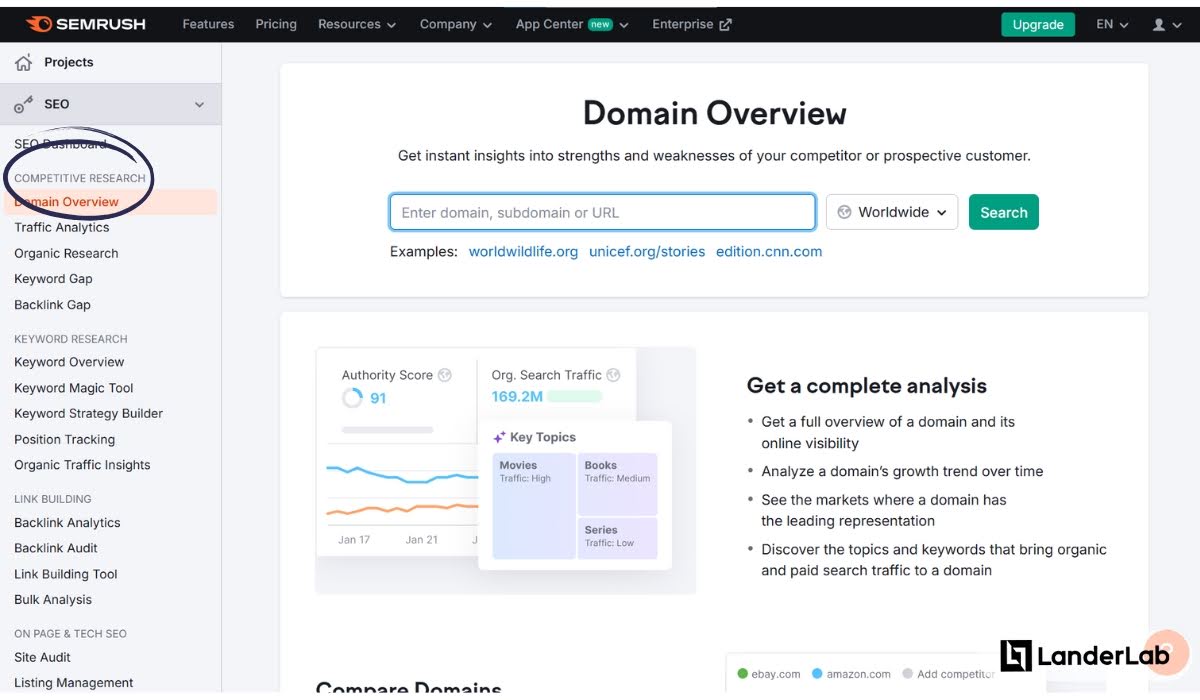
When searching for landing pages based on keywords, niches, traffic sources, affiliate networks, and more, use ad spy tools like Adplexity or Anstrex.
5. Avoid Past Mistakes & Repeat Successes
If this is your first time creating a landing page, congratulations! You have all the leeway to get started and see where it takes you.
As you develop and gather data from your past experiences, you’ll better grasp what doesn’t work and what works best for your business. Make sure you take note of recurring issues, including landing page mistakes to avoid, so you can continuously improve your results.
6. Track and Monitor Campaigns
Businesses tend to forget this after a lengthy design process, so let’s put it ahead: don’t waste historical data.
Track your mistakes and successes, and use them to guide your future projects. These will be crucial to your landing page optimizations. Here are some tools you can use for tracking:
Google Analytics and Google Search Console
Take advantage of these free tools to watch out for traffic, sessions, organic clicks, and more. You can use UTMs for tracking or segment customers and traffic sources.
Heatmaps
Use heatmaps to observe user behavior on your web page, including where users click.
Session Recordings
View user session recordings to pinpoint issues they may be encountering.
Third-Party Tracking Tools
These help you accurately track advertising campaigns, monitor the flow of traffic to your landing pages, and pinpoint which landing pages helped deliver the most conversions.
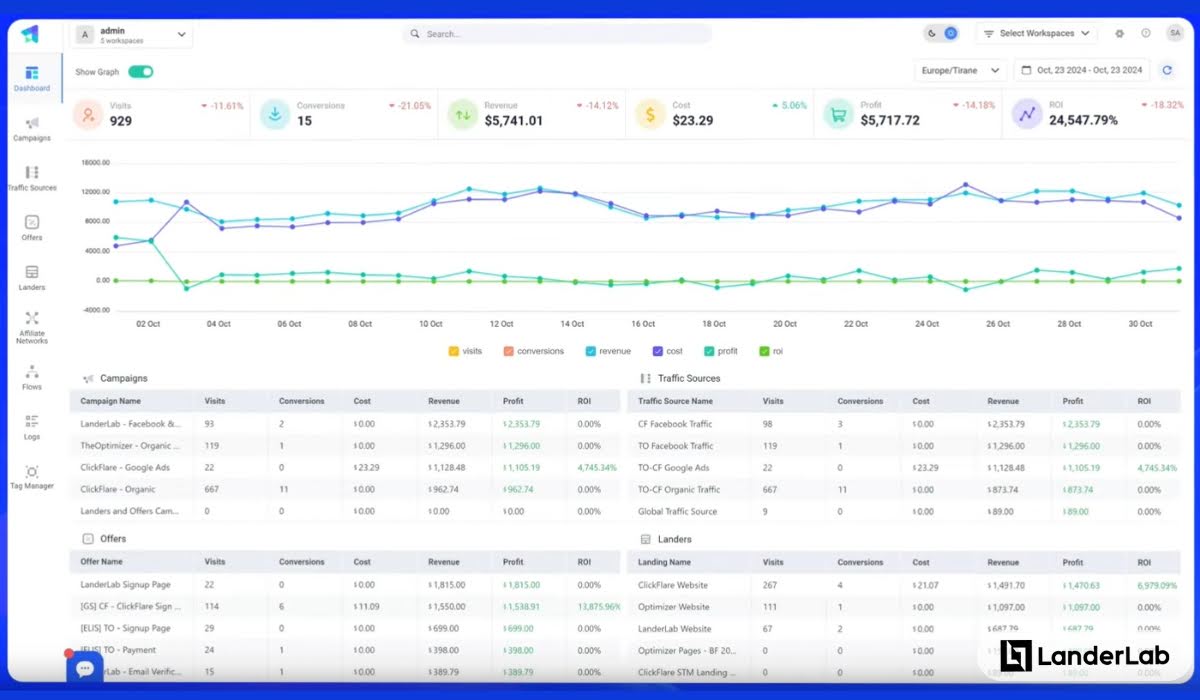
The Core Elements of a Landing Page
So you have your creative brief, you have studied your competitors, and your domain is ready. It’s now time to build it!
A well-designed landing page combines strategic elements to guide visitors toward a single conversion goal while building trust and addressing their needs.
Here are the core elements of an effective web page:
7. Hook Users with the Headline
Your headline is the first thing visitors notice. It should communicate your value proposition immediately, highlight your offer, and hook them to take action.
Convincing and direct headlines like “Boost Your Conversions with Our Landing Page Builder” work better than the typical “Welcome to Our Site.”
Here are some tips for crafting an optimized and attention-grabbing headline:
Align with the Goal
Your headline should align with your desired action. Are you inviting them to a webinar? Are you offering a PDF checklist or a template?
Ask a Question
Questions engage the reader’s mind and create curiosity that demands resolution. “Are You Struggling with Losing Weight?” or “Does the usual skin care make you break out?”
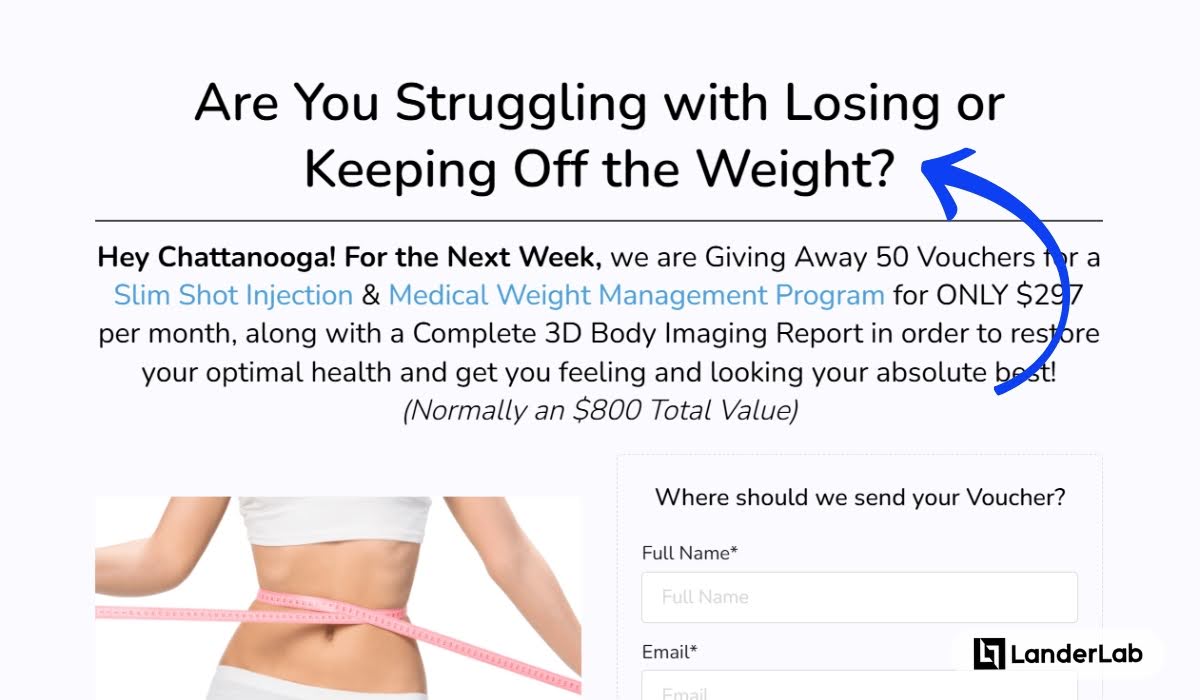
Build optimized landing pages without touching code.
Solve a Problem
Directly address your target audience’s pain points to show immediate relevance.
Highlight Urgency
Words like “now,” “today,” or “limited” can trigger FOMO and prompt immediate action. But don’t overdo it!
Use Power Words
Emotional terms like “essential,” “ultimate,” or “proven” evoke strong reactions that drive engagement.
8. Write Clear Copy
You can’t put all the information in the headline, so your copy should be able to supplement it.
Use this opportunity to expand on your value proposition. The copy can elaborate on your benefits, features, and guarantees.
Here’s how to do that:
Be Brief
Use bullet points and brief paragraphs to make your writing easier to read. Avoid jargon and use language relevant to your audience.
Emphasize Benefits
Describe how your offer improves their life or solves a problem. Highlight this more than the features.
Use Persuasive Copywriting
Encourage your audience to take the required action with persuasive language. Pique their interest by using principles of conversion copywriting.
Offer possible solutions to their pain points. Tell them why yours is the fix they need.

9. Compose an Engaging Call to Action (CTA)
Your landing page is only as effective as your CTA. It is the key to your conversion.
Users can go through the page and not convert if it is unclear or easily noticeable, so this can make or break your campaigns.
Here’s how to compel your users to take action:
- Make sure your CTA button is easy to see.
- Repeat CTAs in long pages.
- Use personal pronouns that create connections. For example, use “I Want In” or “Show Me.”
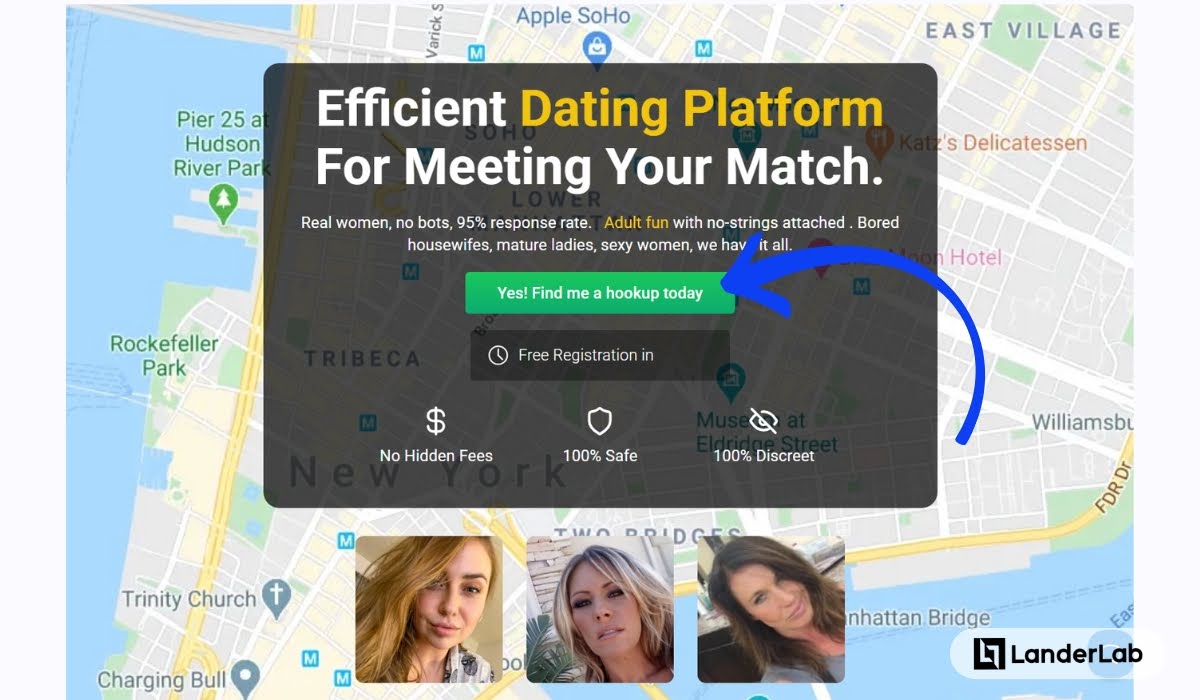
- Use emotionally charged words that trigger interest.
- Make it sound exclusive.
- Use verbs that prompt action, such as “Start my Journey,” “Get Free Tools,” and “Watch Now.”
- Make sure your buttons and link are similar.
Recommended Reading: 12 Call to Action Examples That Get Clicked (Tested)
10. Leverage Eye-catching Visuals
Imagine a landing page with just text. Pretty dull, right?
Visual elements draw viewers in and make them scroll through your page. This includes images, graphics, and icons.
Here are some tips for optimizing visual content in landing pages:
Cue Sections
Since the brain processes visual content more quickly, it is an effective tool for engagement. Icons and graphics lead the eyes toward crucial copies.
For example, arrows can guide users to the CTA. Simple bullet points keep texts easy to read. A new image can convey a change in information.
Complement your Content
Use relevant images for your offers. If you offer a template bundle, use mockups to show how it looks on different devices.
If you provide free training, show what it would be like to participate in it (even if it’s online).
Strengthen your Brand
Professionally shot photos and high-resolution images make a good first impression.
If your landing page offers restaurant bookings, pictures of food will be inviting. For beauty products, images of sample products are attractive.
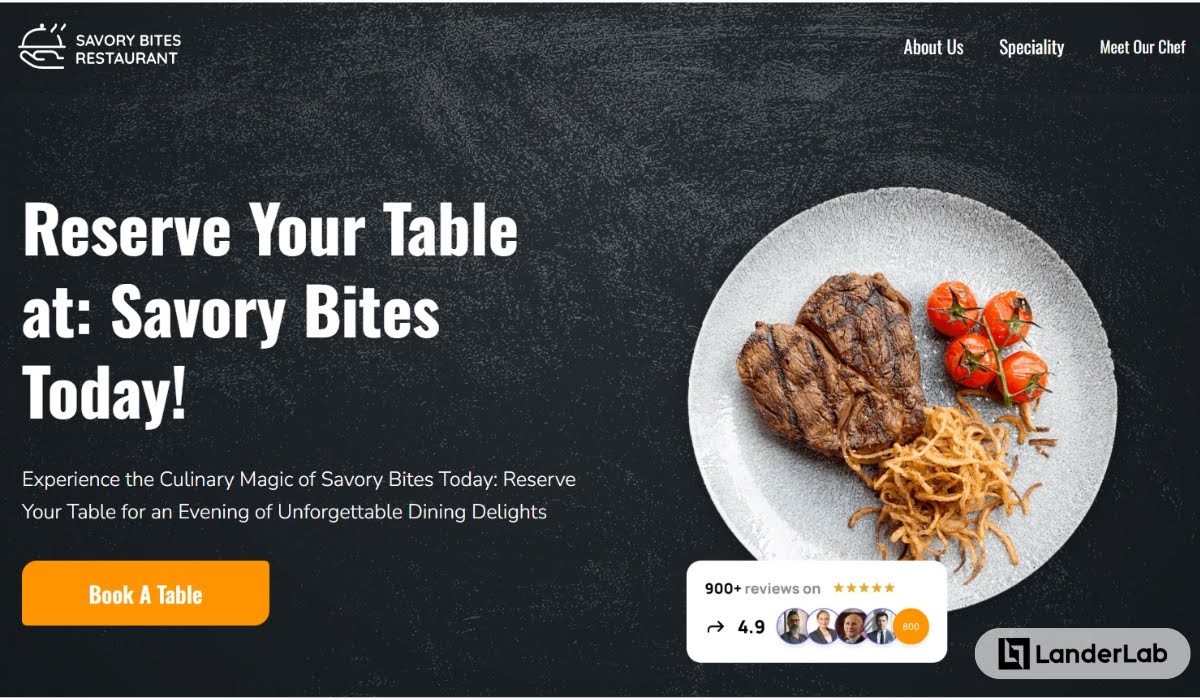
Optimize Images for Page Loading
Visual content tends to be heavy on landing pages, so ensuring they are optimized for fast page loading is imperative.
Use lower-resolution images and use smaller file formats like webp. Be careful not to overdo it, crappy photos can be just as a turnoff as a slow page.
11. Engage the Audience with Videos
Adding videos to your landing pages can help you share more information with your audience in less time. Plus, videos are the most consumed content nowadays.
Videos work best on complex offers or products. Optimize your videos by following these tips:
Put it Above the Fold
On average, viewers stay on a landing page for 15 seconds. If you’re using a video as your primary information delivery, ensure viewers see it immediately.
Create an Engaging Thumbnail
Make the video thumbnail catchy to compel users to hit the play button.
Avoid Autoplaying Videos
It can get annoying when you can’t figure out where the sound is coming from. You won’t need it if you truly optimized your video according to our tips.
Give your user the ability to control the video player. Some pages autoplay on mute, but playing videos is heavy on data and your landing page may load slowly. That’s equally a turn-off.
Use Captions
Subtitles make videos easier to watch and understand, so consider adding them.
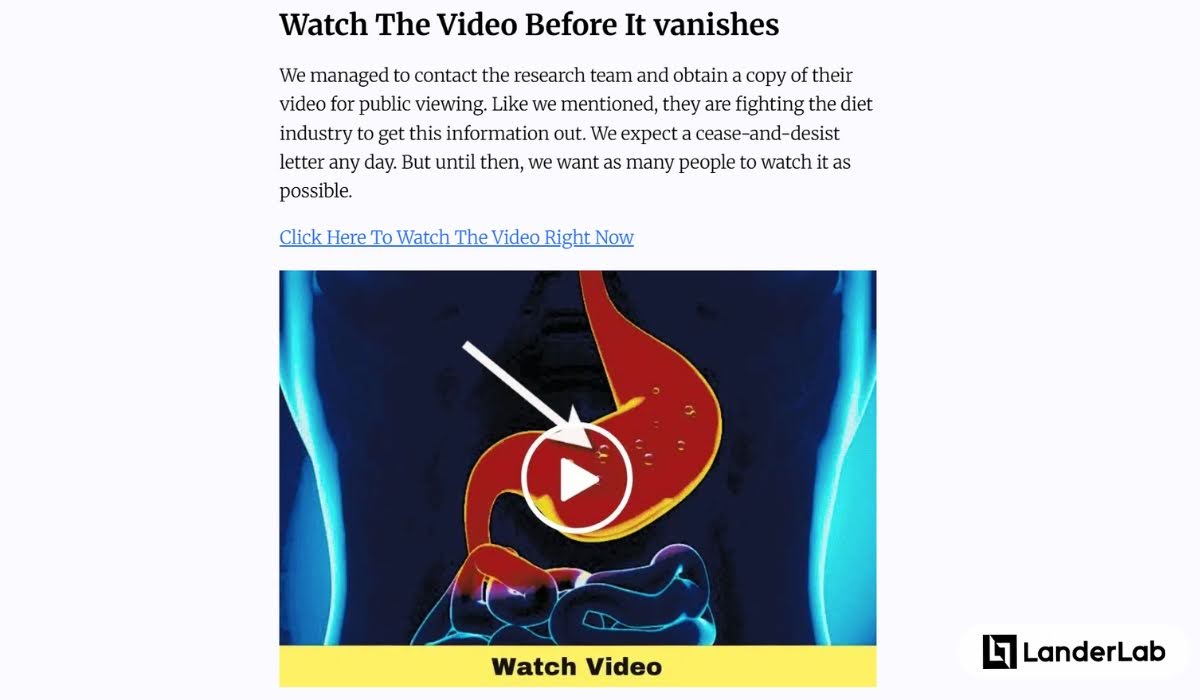
12. Keep Forms Simple
If generating leads is the main objective, the form should be straightforward. Although it may be good for qualifying leads, a lengthy or complex form may discourage users from converting.
Optimize your forms with these tips:
Reduce Fields
Only ask for truly necessary information to decrease friction and boost submissions.
Add Inline Validation
Give users immediate feedback to ensure they are filling out forms accurately.
Secure Forms
Tell viewers what the form is for, what they will get after submitting it, and how you use their data. They’re giving you sensitive information, so give them a sense of security.
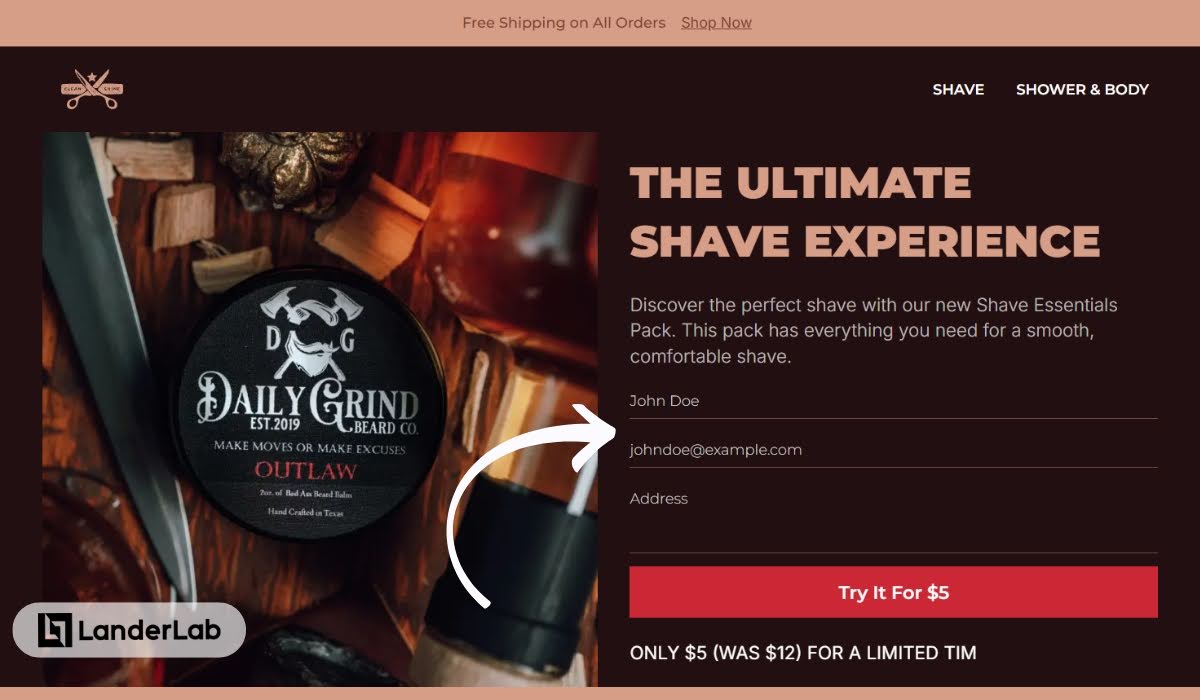
13. Avoid Annoying Popups
Limit the number of pop-ups that appear on users. Annoying pop-ups drive visitors away before they engage with your content.
They create friction in the user experience, interrupt the customer journey, and significantly increase bounce rates.
They’re particularly problematic on mobile devices where screen space is limited and accidental dismissals are common.
Instead, use less intrusive methods like slide-ins or timed offers that appear after meaningful engagement with your page.
14. Add Trust Signals
These build credibility with potential customers. Trust indicators help reduce anxiety around purchasing decisions by showing that others have had positive experiences with your offers.
It also communicates that your business is legitimate and respected within your industry. Here are some trust signals you can use to optimize your landing pages:
-
Testimonials
-
Reviews
-
Case studies
-
Client logos
-
Certifications
-
Trust Badges & Seals
-
Terms & Conditions and Privacy Policy Links

15. Provide Extra Value on Confirmation Pages
When users convert, they expect a confirmation of what they get.
Lead them to a thank you page and give them extra value, such as the next steps, extra resources, or a discount on a paid offer.
Then, send them an email confirming their submission. This way, you keep them informed throughout their customer’s journey.
16. Make It Mobile-Friendly
Optimizing landing pages for mobile is now a requirement as users rely more on their phones.
Here’s how to make sure your pages are optimized for mobile:
- Employ Mobile Responsive Design Strategies
- Ensure Quick Loading
- Keep a Simple Layout
Landing page builders already have built-in ways to edit a website or page according to mobile resolution, so use it.
However, it’s best to use a landing page builder that offers true mobile responsiveness, like LanderLab. This way, you won’t have to go back and forth making sure your landing page looks good on whatever screen size.
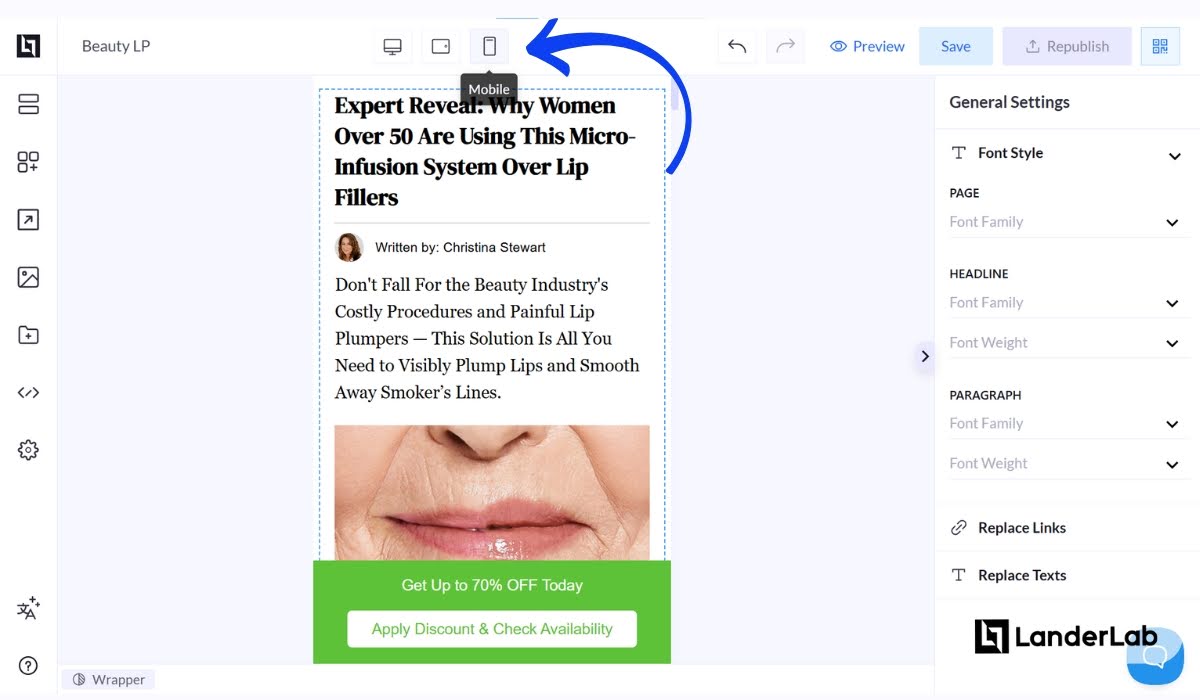
Other Best Practices for Optimizing Landing Pages
Once you’ve built the core elements of your landing page, and you may have been able to publish it already, it’s time to monitor its performance!
Here are a few standard practices in optimizing a landing page:
17. Boost the Speed of Loading
A page that loads slowly may turn people away. Use resources such as Google PageSpeed Insights to assess and improve your page’s speed. Faster sites also enhance user experience and increase search engine rankings.
Here are some tips for optimizing speed:
-
Lessen animations
Unless necessary, try to lessen the use of animated elements in your landing pages.
-
Minify Code
To minimize file sizes, minify HTML, CSS, and JavaScript.
-
Use a Content Delivery Network
A content delivery network (CDN cache) caches your content on servers near your users, speeding up content delivery.
LanderLab allows you to integrate your Cloudflare account within the platform, making sure that all your landing pages use a CDN automatically.
18. Run A/B Tests
Systematic testing reveals which specific elements resonate best with your target audience. Landerlab allows you to create A/B test landing pages to try different combinations of headlines, graphics, copy, and CTAs.
Here are some tips when running A/B tests:
-
Test One Aspect at a Time
-
Follow a Methodology
-
Analyze Outcomes
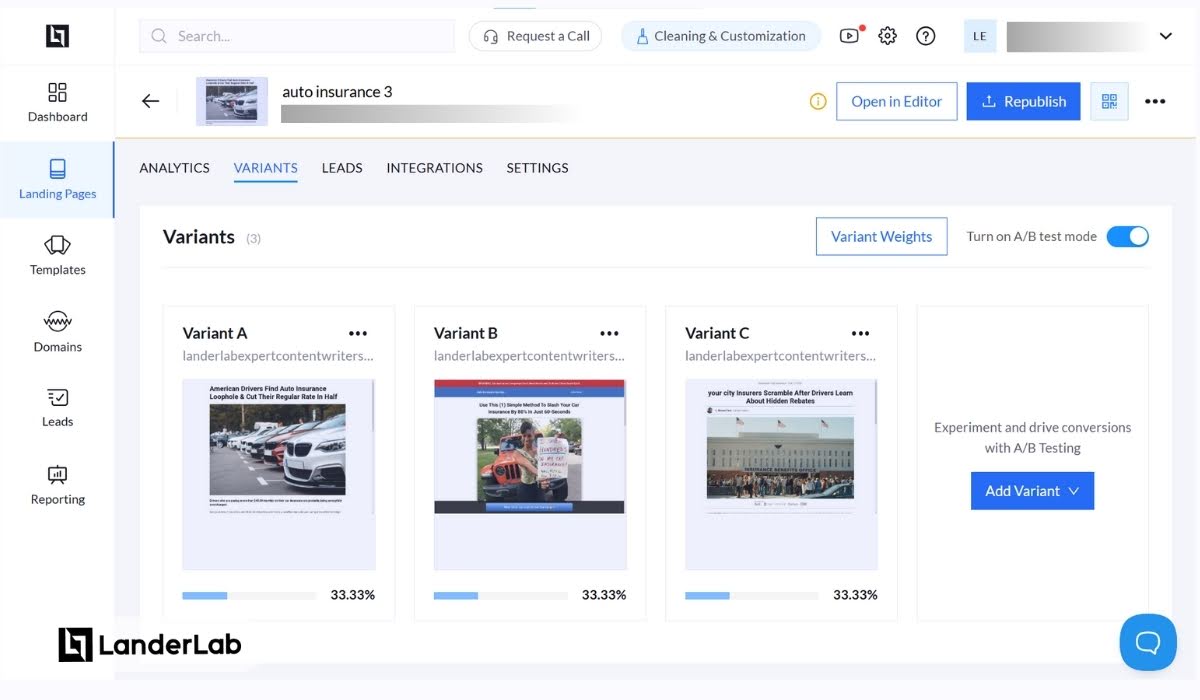
19. Gather Audience Feedback
Who better to give your recommendations on how to optimize your landing pages than your own audience?
Ask them for feedback: Did they easily find what they were looking for? What’s stopping them from accepting your offer?
Use these insights to guide your landing page optimization strategies.
20. Keep Optimizing!
User behavior and market trends constantly evolve, so landing page optimization requires consistency. Keep testing your landing pages.
Final Thoughts on Landing Page Optimizations
Landing page optimization is a continuous process that requires data-driven decision-making and strategic implementation of best practices.
This comprehensive guide is basically a checklist of all the things you need to watch out for during the design process. From pre-launch planning, core element optimization, and post-launch testing, these best practices can significantly improve your conversion rates.
Implement these landing page optimization practices and analyze performance data consistently to ensure your landing pages are robust in 2026 and beyond.
Keep in mind that LanderLab provides all the resources you need to easily create and optimize high-converting landing pages, making creating them smooth and effective.
Optimize Landing Pages That Actually Convert
Use LanderLab to build and test landing pages that follow proven optimization strategies. Run A/B tests, analyze results, and improve performance with every click.




